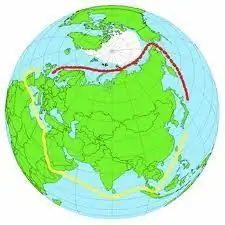2025 Author: Howard Calhoun | [email protected]. Last modified: 2025-01-24 13:10:35
The Northern Fleet was created much later than the B altic, Black Sea and Pacific. The importance of the polar theater of operations increased significantly in the early thirties of the XX century. Achievements in aviation and shipbuilding made it possible to conclude that the protection of territories in which it was previously impossible to conduct military operations was a priority.

The People's Commissar of Defense of the USSR Klim Voroshilov in April 1933 signed an order to transfer the squadron, consisting of the destroyers "Kuibyshev" and "Uritsky", two submarines and two guards to the polar zone. The caravan of ships was named EON-1 (special purpose expedition). The ships formed the basis of the military flotilla formed in Murmansk. In August, large-scale construction of a new naval base in the city of Polyarny began.
In 1935, the Northern Flotilla began training and combat work. Within a short period of time, in just two years, many long-distance crossings were made, in particular to Novaya Zemlya and along the Northern Sea Route, experience was gained in under-ice navigation of submarines, airfields for naval aviation were built, and household and auxiliary infrastructure was organized. In May 1937, the Northern Fleet was created on the basis of the flotilla.

The thirties became the era of the development of the Arctic. The rescue of the expedition of I. D. Papanin was carried out with the active participation of sailors and pilots from the North Sea.
The Northern Fleet took part in the Finnish winter war. The strategically advantageous location of the main base made it possible to block enemy supplies from the sea. The ports of Petsamo and Liinakhamari were occupied by Soviet sailors.
Since June 1941, the importance of the Soviet northern ports has increased significantly. Arkhangelsk and Murmansk accepted the help of the allies, their defense became a vital task. During the four war years, more than one and a half thousand convoys passed through the Atlantic, each of which met our ships hundreds of miles away, escorted them to their ports of destination, repelling attacks by German torpedo bombers, submarines and bombers.

The Northern Fleet actively counteracted the German Kriegsmarine forces. The Nazis lost more than six hundred ships and 1,300 aircraft in the polar latitudes. Submarine heroes Nikolai Lunin, Ivan Kolyshkin, Israel Fisanovich, Mohammed Gadzhiev and many others did everything they could to win, sacrificing their lives if necessary. Pilots from the North Sea Boris Safonov, Ivan Katunin, Pyotr Sgibnev covered their red-star wings with unfading glory in the Arctic sky.
Starting from the fifties, the Northern Sea Fleet has become not only an ocean fleet, but also a missile one. The world's first ship-based ballistic launch was made in 1956 in the White Sea. Three years later, the Severomorians adopted the K-3 submarine missile carrier. Lenin Komsomol. 1960 marked the world's first underwater launch of a ballistic intercontinental missile.

In 1962, the Northern Submarine Fleet conquered the Pole. The missile carrier "Leninsky Komsomol" took the surface position, breaking through the ice with its hull, and the sailors set at a point with a coordinate of 90 degrees N. sh. flags of the USSR and the Navy.
In the second half of the seventies of the XX century, aircraft carriers were included in the Northern Fleet. The first of these was the cruiser "Kyiv", in 1991 the aircraft carrier "Admiral Kuznetsov" took up combat duty.
Historical realities have shown how far-sighted was the creator of the Russian Navy, Peter the Great. More than three centuries ago, when guiding the first Russian ships in northern waters, he prophetically understood the future strategic importance of the North in protecting the country.
Today, the area of responsibility of the Northern Fleet of Russia is the entire world ocean. Based in Severomorsk and Severodvinsk opens up opportunities for unlimited operational space.
Recommended:
Destroyer "Persistent" of the Russian B altic Fleet

The flagship of the Russian B altic Fleet - the destroyer "Persistent" - is a representative of the class of destroyers of the "Modern" type. According to the classification, this is a 1st class warship, equipped with missile weapons and capable of operating independently away from groupings, in the far ocean zone. In the Navy, he received the unofficial name "Nastya"
Northern Sea Route. Ports of the Northern Sea Route. Development, significance and development of the Northern Sea Route

In recent years, the Arctic is one of the key regions in terms of Russia's national interests. One of the most important aspects of Russia's presence here is the development of the Northern Sea Route
Fishing industry. Fishing fleet. Fish processing enterprises. Federal Law "On Fishing and Conservation of Aquatic Biological Resources"

The fishing industry in Russia today is one of the most promising industries. Its development is paid attention, including by the state. This applies to both the fishing fleet and various processing enterprises
Russian fleet. Navy of the Russian Federation

What is this - the Russian fleet? What are the goals of its activities? What associations are included in it? Let's analyze the structure of the Navy, get acquainted with the command. In conclusion, let's talk about the current state of affairs and development prospects
Brick heating shield - features, device and design diagram

The heating shield will become an indispensable assistant if such devices as a potbelly stove are used indoors. Although it is worth noting that they have a couple of rather serious disadvantages that can alienate potential users

